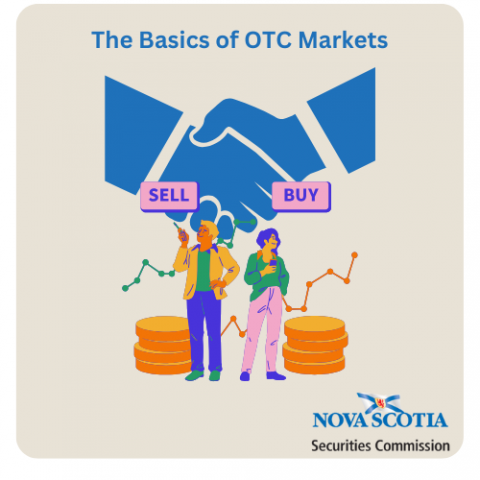Submitted by nsscadmin on

Recently, during an investor education presentation we were asked about over the counter (OTC) markets. Specifically, we were asked where the OTC markets are and how one goes about trading on them. If one person has this question, they others likely do as well, which is why we’re addressing it in today’s blog post.
Before we get started, a reminder that the Nova Scotia Securities Commission does not provide investment advice. We are not advising or recommending trading on OTC markets. This post is simply to educate investors on OTC markets so they can be informed when working with their adviser and making investment decisions.
OTC markets are not a physical place. You don’t head down to the OTC market to trade securities. Like other securities marketplaces, the OTC markets are online. However, there are some key differences between trading securities listed on a registered exchange, such as the TSX, and trading securities on OTC markets.
An OTC market is a decentralized market where two parties can trade stocks, commodities, currencies, or other instruments directly without a central exchange or broker. When it comes to securities being traded through OTC markets, they are not listed on a stock exchange, and fall into the “penny stocks” category, meaning they are valued at less than $5 per share (and usually trade at a fraction of that amount). Stocks traded on OTC markets typically have much lower liquidity than stocks that trade on exchanges.
Most OTC market trading takes place in the United States on platforms operated by OTC Markets Group, including the OTCQX, the OTCQB, and the Pink Open Market. These platforms are regulated by the Financial Industry Regulatory Authority (FINRA), which is an American self-regulatory organization, but do not adhere to the more robust regulatory standards enforced by registered exchanges. Not all brokers provide access to the OTC platforms offered by OTC Markets Group.
Here are some of the main differences between exchanges and the OTC markets:
|
|
Exchange |
OTC Market |
|
Trading Platform |
May have a physical location (such as the New York Stock Exchange trading floor) |
No physical location |
|
Pricing |
Mainly determined by auction (bids and asks) |
Negotiated between buyer and seller |
|
Issuer Disclosure |
Exchange-listed issuers are required to disclose extensive information on an ongoing basis |
OTC issuers are not required to disclose the same amount of information |
|
Transparency |
Publicly report trades and price information |
Do not publicly report trades and price information |
|
Regulation |
Subject to oversight by statutory regulators (such as the Securities and Exchange Commission (SEC)) |
Subject to oversight by FINRA |
|
Liquidity |
Usually higher liquidity (easy to trade at a predictable price) because larger pool of participants and market features like market makers |
Wide range of liquidity; some securities may be extremely illiquid (difficult to trade at a predictable price) |
|
Asset Availability |
Typically limited to stocks, bonds and derivatives |
Stock, bonds, and derivatives are available on OTC markets, but investors can also find a wide range of other assets, such as commodities, foreign currencies, crypto assets and structured products |
|
Access |
Widely accessible to retail investors through a range of financial institutions |
Not all financial institutions provide access to OTC market for retail investors |
The most important difference between trading on an exchange and trading on an OTC market is risk. Trading on OTC markets comes with added risk for several reasons, the most important of which are:
- A lack of reliable information about the issuer of the security
- A potential lack of liquidity, which results in wide bid-ask spreads and unpredictable price movements.
If you are interested in trading assets on the OTC market be aware that you are taking on much more risk than trading on an exchange. Be sure you fully understand these risks and that you’re comfortable taking them on. Investors should also be aware that there have been many examples of fraudsters using OTC markets for fraudulent purposes such as pump and dumps, and Ponzi schemes.
